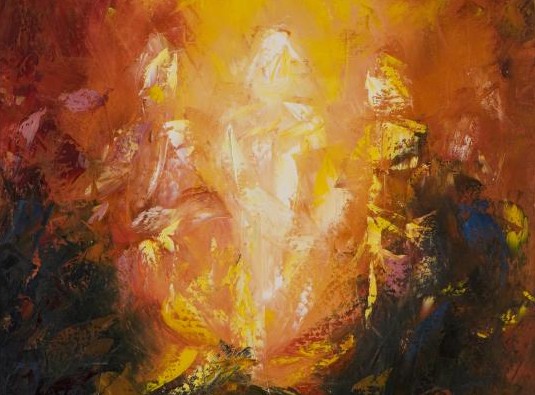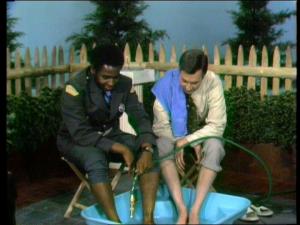Dazzled
Mark 9:2-9
It’s good to be back with you today! As you can see, I’m preaching one-armed this morning, as I’m recovering for a few more weeks from shoulder surgery. My colleagues have been giving me a hard time, sure that I can’t, in fact, preach with one hand, (probably because of my well-known pulpit-pounding, fire and brimstone preaching style). Thank you for all your prayers and expressions of care and concern.
Today is the final Sunday of the season after the Epiphany, the Sunday of Transfiguration. You’ll recall if you’ve been following along these last weeks, that we’ve been leaning toward the light, squinting for glimpses of God in the stories we’re reading about Jesus. I’ve been telling you about a metaphor a colleague shared with me several years ago, that these weeks after Epiphany are like walking into your dining room and pressing the light switch. When you do, the switch clicks the ceiling light fixture on at its dimmest; as you turn the knob on the switch, the light gets brighter and brighter.
We started this season after Epiphany with the story of Jesus’ baptism, when everybody in Jerusalem and surrounding areas trudged down to the Jordan River to try to catch a glimpse of John the Baptist, baptizing people. When they did, they encountered Jesus, newly baptized, and witnessed the voice of God announcing that this was someone special, someone we should be listening to. It was like turning on a switch, noticing for the first time that a light had come on somewhere, even if it seemed hard to see at first.
Potential disciples scrambled then, sliding down the muddy river banks to get closer, and eventually abandoning fishing nets and tax collecting ledgers to follow Jesus.
Over the past few weeks we’ve heard stories of that following, and we’ve observed that Jesus’ disciples were among the most dense, disbelieving, and uncomprehending characters you might ever meet. Everywhere they went they saw Jesus healing the sick, calming the storms, feeding the hungry. They listened to him speak, in stories and even very directly, about his ideas that the kingdom of God is at hand—God is here, and working hard to redeem our broken world. Don’t you want to be part of what’s going on?
Over and over again he invited them: join in! Give up your lives and follow. Love each other with lavish generosity! Challenge the forces of evil, speak truth to power. Give up your lives through vulnerable engagement. Believe there’s something more than what you see right in front of you.
Three years.
Three years the disciples had followed and listened and learned (or not, as the case may be). They had front row seats to the work of God in this world. They had every opportunity to watch closely as the dial on the light switch turned up and up and up, showing the world in perhaps one of clearest and most compelling ways, what God is up to and how they might jump right in and be part of God’s work in the world.
But those disciples never seemed to quite get it. They are, especially in the gospel of Mark, like a Laurel and Hardy skit—over and over they fumble around, perpetually missing the point.
As the beginning of my reentry to work, just this past week I traveled to Kansas City, where I taught an intensive Doctor of Ministry course at Central Baptist Theological Seminary. The topic of the course was leadership, specifically the person and perception of the leader, so we began our work by talking about common impressions people have of pastors, church, the Bible. You might imagine the list of descriptors the class compiled: boring, stodgy, irrelevant, no fun, straight-laced—you know, adjectives like that. There are those who really believe, say, that the Bible is boring and dry; that Jesus is a character who walks around spouting pious sayings; that the whole book is full of stories of holier-than-thou people whose experiences have nothing to do with ours.
But as you and I well know, those couldn’t be further from the truth…there are some church-going folk who are the life the party—I can see some of you out there now! And, if you read carefully, there are parts of the Bible that are really quite funny. Today’s passage from Mark’s gospel is a perfect example.
Let’s take a look:
Today’s text says Jesus took three of his disciples with him one day on a little hike. Up the mountain they went, talking about all the things that had transpired, Peter super enthusiastic, James and John wondering if this career risk they’d taken was really going to pay off as they’d hoped.
The text says that suddenly along the way, Jesus was transfigured before them. I’m not sure what that means exactly, except that it had something to do with light: dazzling, shining light, like the sun. It was like turning the dining room light switch all the way up until the floodlights came on, and, in true descriptive form the text says: “his clothes became dazzling white, such as no one on earth could bleach them.”
The disciples didn’t know what was happening, especially when Moses and Elijah showed up and they heard the voice from heaven confirming what they’d hoped all along: this is my beloved Son, listen to him!
And what were the disciples thinking? Maybe something like this: Yes! For once in our hardscrabble lives we’ve made the right call, taken a chance that’s going to pay off big time! Jesus is going to overthrow the Roman government; we’re on our way!
And so, in response to this amazing experience, Peter suggested what seemed only reasonable: let’s build something. Let’s celebrate that we’ve made it! Let’s hang on with all we’ve got to this shining, illuminating moment where we can see God so clearly and where the darkness of our lives is banished, once and for all! How about, three monuments, tangible structures by which we can remember this experience??!
And the text says that Jesus did not know what to say.
Jesus did not know what to say.
Here’s where it seems so funny to me, because while Jesus did not know what to say, I can guess what he was thinking.
Seriously? Seriously??!?!? You mean to tell me that you have followed me around for three years, I have explained over and over and over again that my way is not the way of this world, that I’m inviting you into the risky, messy work of reconciliation, and this is what you think we should do? Build a monument? Institutionalize the work of radical love?
Jesus did not know what to say.
Ah, we humans. Even back then, on a mountain in Galilee, institutional religion—that amazing gift and terrible burden—was raising its hand, demanding attention.
Here’s how it goes. Individually and corporately we come to a moment in our lives where we’re seeking God. We’re searching for comfort, answers, hope, community. Somehow we wander into faith community and we very often meet God there. We find the solace we need, we’re grafted into relationships that heal us, we understand in new ways the interplay between God and the world.
And we want to hang on tight to those feelings of clarity and purpose, so tight that we build buildings and erect monuments and hold meetings and write bylaws to make sure we’ve captured a little bit of God, that light that will shine forever and make everything okay.
So we know exactly how Peter, bless his heart, felt when his excitedly suggested a monument-building campaign.
But what Peter, James, and John didn’t realize that day up on the mountain, bathed in the light of God’s love, was that they had not, in fact, reached the pinnacle of their adventure with Jesus. They thought they’d made it; that all their struggling to follow and listen and understand had finally paid off.
But this bright and shiny miracle wasn’t the culmination of Jesus’ work, was it? That wasn’t, and the church as we know it certainly isn’t.
This passage in Mark is just the halfway point in the story of Jesus’ ministry. Beginning with his baptism and through all the stories of encountering people and preaching the gospel message, we’re only halfway there.
The other half is just beginning, and it’s going to be a half filled, not with light and celebration, feeding and healing, vindication and culmination. No, you know: it’s a half filled with darkness and suffering, humiliation and pain, abandonment and…death.
 Here, dazzled by the light, we’re only halfway between baptism and the cross. There’s still a ways to go, and the way ahead is a hard, treacherous way for sure.
Here, dazzled by the light, we’re only halfway between baptism and the cross. There’s still a ways to go, and the way ahead is a hard, treacherous way for sure.
It’s easy for us to make fun of the disciples; after all, hindsight is 20/20, you know they say. But on this Sunday of Transfiguration it might be worth the consideration that perhaps, somehow, we’ve seen the light and we’ve become distracted by it, too—dazzled, you could say, just as confused and bewildered as Jesus’ first disciples. Will we stay here, dazzled by the light, or will we have the courage to take the light into the darkness of this world? That was their question, and that’s ours, too.
The conundrum the disciples experienced that day, and the profound way in which we often misunderstand Jesus, makes me think of this famous passage from Teaching a Stone to Talk, by naturalist and writer Annie Dillard. She writes about the challenge of being the church in the messiness and reality of gospel transformation, of turning from our own preoccupation with lofty images of God toward the substance of God’s work in the world:
“On the whole, I do not find Christians, outside of the catacombs, sufficiently sensible of conditions. Does anyone have the foggiest idea what sort of power we so blithely invoke? Or, as I suspect, does no one believe a word of it? The churches are children playing on the floor with their chemistry sets, mixing up a batch of TNT to kill a Sunday morning. It is madness to wear ladies’ straw hats and velvet hats to church; we should all be wearing crash helmets. Ushers should issue life preservers and signal flares; they should lash us to our pews. For the sleeping god may wake someday and take offense, or the waking god may draw us out to where we can never return.”
Today is Transfiguration Sunday, the day we recall finally, finally seeing Jesus for who he is, dazzled by the light of God’s presence in and through him. But God’s point in this transfiguration is not to show off, to create something so far out of our reach that all we can do is stand there, dazzled.
No, God’s point in this transfiguration is to say: I am here. I am with you, in the world, God with skin on. My work here is to transfigure you, too, and this whole world, so that the light we all seek will flood into the darkest corners of human life and human hearts, and change the world.
That day the disciples eventually turned and trudged back down the mountain, Jesus at their side, no monument building plans to speak of. They couldn’t know what was just around the corner for them: a confrontation with darkness in which it would seem at several points that the darkness had won.
But, as we know, it didn’t really. There was just enough light left over, shining off of Jesus onto them, ricocheting into the world, sometimes in tiny points of light or faded shadows, even, but it was there. And it is here.
This Wednesday we begin the season of Lent, 40 days of confession and repentance, a slow journey toward the cross. It is a dark and somber time, the final week of which will bring us right to the edge of the darkness.
But we know the darkness will not win, because like the disciples we have been dazzled by the light that will not go out, not matter how bleak the situation seems.
So for now we gather the courage to hold the promise of the light close, to turn and trudge back down the mountain with Jesus, and to live believing that, having seen the light at its brightest, we know for sure: no matter how deep the darkness, the light will not go out.
Amen.











